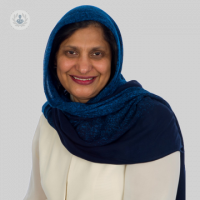Navigating cancer care: A comprehensive guide to Sentinel Lymph Node Biopsy (SLNB)
Written by:Sentinel Lymph Node Biopsy (SLNB) is a critical diagnostic procedure that plays a pivotal role in the assessment and management of various cancers. In her latest online article, Professor Amtul Razzaq Carmichael explains the operation of SLNB, delving into its purpose, procedure, benefits, risks, and the individuals who may benefit from this medical intervention.

What is a sentinel lymph node biopsy (SLNB)?
A Sentinel Lymph Node Biopsy, commonly known as SLNB, is a surgical procedure employed in staging of breast cancer. The sentinel lymph node, often the first node to receive drainage from a tumour is identified and removed. This lymph node is looked under the microscope to determine if cancer has spread to the nearby lymphatic system.
How is a SLNB performed?
The SLNB procedure involves the injection of a tracer or dye near the tumour site, allowing surgeons to locate the sentinel lymph node accurately. Once identified, the sentinel lymph node is removed and examined for the presence of cancer cells. This procedure eliminates the need of more extensive lymph node dissections in many patients.
What are the benefits of SLNB?
SLNB offers several advantages in cancer diagnosis and treatment. Firstly, it allows for a targeted approach, focusing only on the nodes most likely to contain cancer cells. This precision helps reduce unnecessary lymph node removal, minimising potential complications. Additionally, SLNB provides valuable information about the extent of cancer spread, aiding in the development of tailored treatment plans.
What are the risks of SLNB?
While SLNB is a safe procedure. There are some risks attached to any operation potential complications of SLNB may include infection, bleeding, or allergic reactions to the tracer. In rare cases, nerve damage or lymphedema (swelling) can occur. It is crucial for individuals considering SLNB to discuss these risks with their healthcare team to make informed decisions about their care.
What is the recovery process for SLNB?
The recovery process for SLNB is generally swift compared to more extensive lymph node dissections. Patients may experience mild discomfort, swelling, or bruising at the biopsy site, which typically resolves within a few days. The majority of individuals can return to their usual activities shortly following the procedure. Follow-up appointments with the healthcare team are crucial to monitor recovery and address any concerns.
Professor Amtul Razzaq Carmichael is an esteemed oncoplastic breast surgeon with over 30 years of experience. You can schedule an appointment with Professor Carmichael on her Top Doctors profile.


